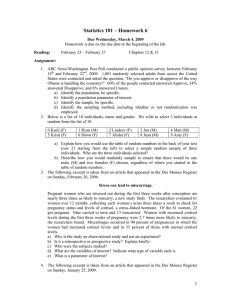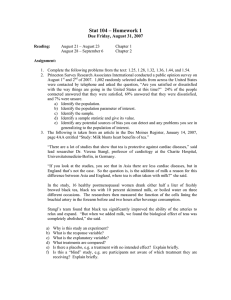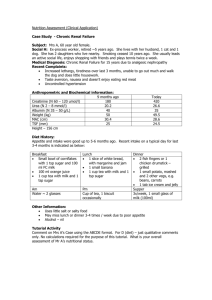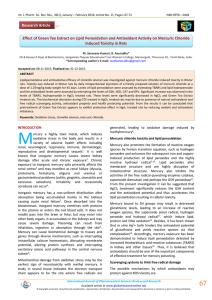Statistics 101 – Homework 6
advertisement
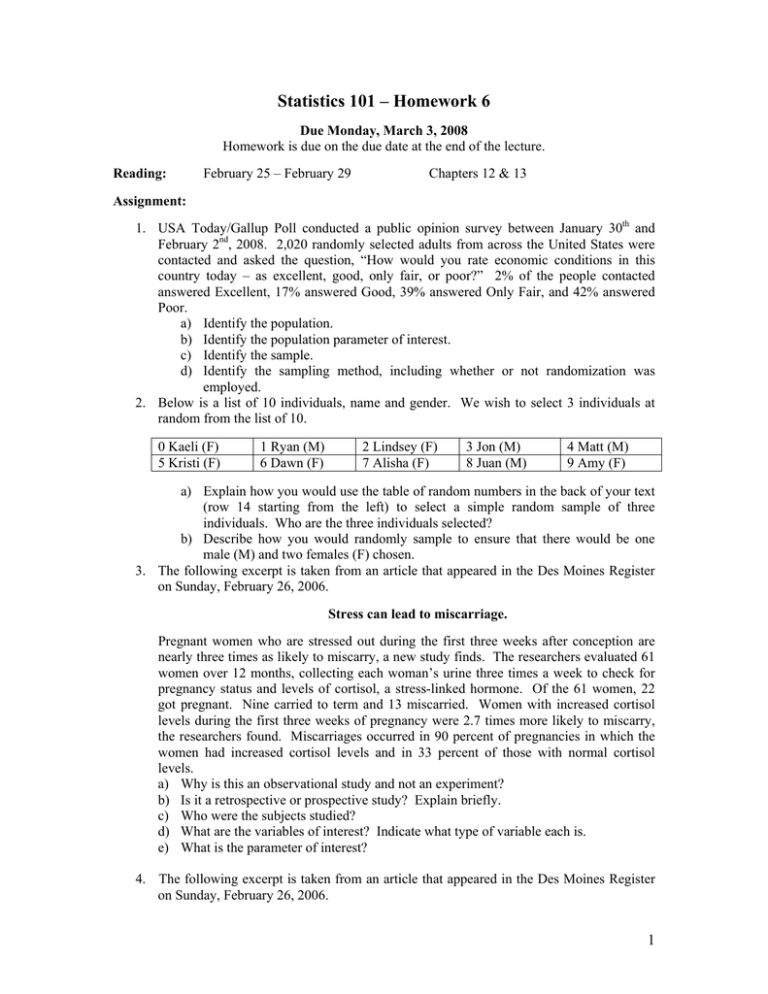
Statistics 101 – Homework 6 Due Monday, March 3, 2008 Homework is due on the due date at the end of the lecture. Reading: February 25 – February 29 Chapters 12 & 13 Assignment: 1. USA Today/Gallup Poll conducted a public opinion survey between January 30th and February 2nd, 2008. 2,020 randomly selected adults from across the United States were contacted and asked the question, “How would you rate economic conditions in this country today – as excellent, good, only fair, or poor?” 2% of the people contacted answered Excellent, 17% answered Good, 39% answered Only Fair, and 42% answered Poor. a) Identify the population. b) Identify the population parameter of interest. c) Identify the sample. d) Identify the sampling method, including whether or not randomization was employed. 2. Below is a list of 10 individuals, name and gender. We wish to select 3 individuals at random from the list of 10. 0 Kaeli (F) 5 Kristi (F) 1 Ryan (M) 6 Dawn (F) 2 Lindsey (F) 7 Alisha (F) 3 Jon (M) 8 Juan (M) 4 Matt (M) 9 Amy (F) a) Explain how you would use the table of random numbers in the back of your text (row 14 starting from the left) to select a simple random sample of three individuals. Who are the three individuals selected? b) Describe how you would randomly sample to ensure that there would be one male (M) and two females (F) chosen. 3. The following excerpt is taken from an article that appeared in the Des Moines Register on Sunday, February 26, 2006. Stress can lead to miscarriage. Pregnant women who are stressed out during the first three weeks after conception are nearly three times as likely to miscarry, a new study finds. The researchers evaluated 61 women over 12 months, collecting each woman’s urine three times a week to check for pregnancy status and levels of cortisol, a stress-linked hormone. Of the 61 women, 22 got pregnant. Nine carried to term and 13 miscarried. Women with increased cortisol levels during the first three weeks of pregnancy were 2.7 times more likely to miscarry, the researchers found. Miscarriages occurred in 90 percent of pregnancies in which the women had increased cortisol levels and in 33 percent of those with normal cortisol levels. a) Why is this an observational study and not an experiment? b) Is it a retrospective or prospective study? Explain briefly. c) Who were the subjects studied? d) What are the variables of interest? Indicate what type of variable each is. e) What is the parameter of interest? 4. The following excerpt is taken from an article that appeared in the Des Moines Register on Sunday, February 26, 2006. 1 Loud music helps drive ecstasy brain damage. Research with hard-rockin’ rats suggests that loud music extends the harmful brain effects of the club drug Ecstasy for up to five days. Researchers at the Institute of Neurological Science in Catanzaro, Italy found that an ecstasy-linked dampening of the rats’ brain activity lasted long after the rodents were given the drug if they also were exposed to music of 95 decibels, the maximum noise intensity permitted by law in Italian nightclubs. If rats weren’t exposed to loud music, the drug’s effects wore off within a day. The team at the Institute of Neurological Science in Catanzaro monitored the rats’ electrocortical activity (EcoG spectrum) using electrodes placed on the rodents’ skulls. a) Why is this an experiment? b) Identify the subjects studied. c) Identify the factor(s) in the experiment. d) Identify the treatments. e) Identify the response variable measured. f) The design is not specified in the article. Explain how this study would be conducted if it were a completely randomized design and make a diagram that shows how such a design would be carried out. See pages 317-318 in the text. Assume you have 20 rats to work with. g) What does this experiment tell us about the effects of loud music and Ecstasy in humans? 5. The following is taken from an article in the Des Moines Register, January 14, 2007, page 4AA entitled “Study: Milk blunts heart benefits of tea.” “There are a lot of studies that show that tea is protective against cardiac diseases,” said lead researcher Dr. Verena Stangl, professor of cardiology at the Charite Hospital, Universitatsmedizin-Berlin, in Germany. “If you look at the studies, you see that in Asia there are less cardiac diseases, but in England that’s not the case. So the question is, is the addition of milk a reason for this difference between Asia and England, where tea is often taken with milk?” she said. In the study, 16 healthy postmenopausal women drank either half a liter of freshly brewed black tea, black tea with 10 percent skimmed milk, or boiled water on three different occasions. The researchers then measured the function of the cells lining the brachial artery in the forearm before and two hours after beverage consumption. Stangl’s team found that black tea significantly improved the ability of the arteries to relax and expand. “But when we added milk, we found the biological effect of teas was completely abolished,” she said. a) Why is this study an experiment? b) What is the response variable? c) What is the explanatory variable? d) What treatments are compared? e) Is there a placebo? Explain briefly. f) Is this a “blind” study, e.g. are participants not aware of which treatment group they are in? Explain briefly. g) Based on a combination of the information in the article and your knowledge of sound study design, make a diagram that shows how you think the study was designed. Hint: Look at page 324 in the text 2
